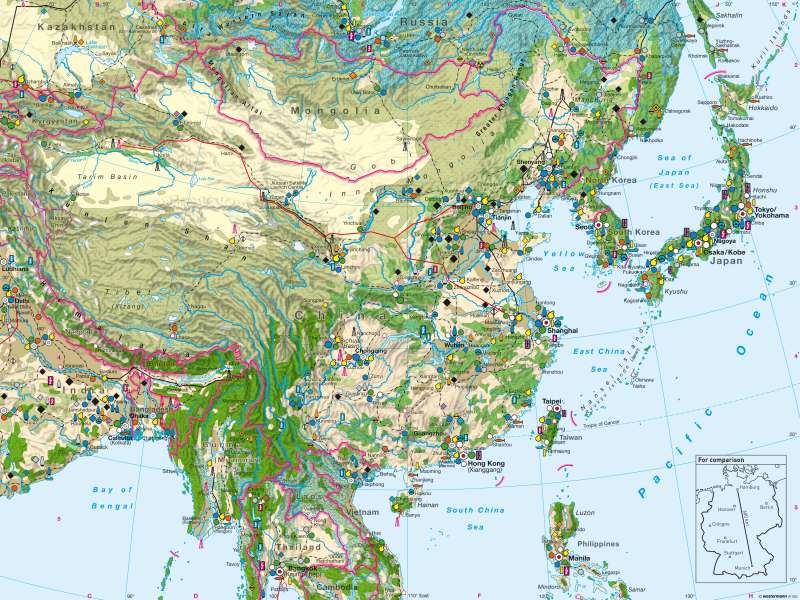Economy
East Asia - Economy
978-3-14-100790-9 | Page 109 | Ill. 3

Information
On the distribution of the signatures for industry, it is easy to discern that Japan has the highest industrial density in East Asia. Japan is among the leading industrial nations in the world, primarily in the fields of steel production, shipbuilding, automotive engineering and in the chemical and electro-technical industry.Industrial development in Taiwan began from 1960 with a more labour-intensive, sophisticated and export-oriented light industry (leather / textile / apparel). From 1970, intensive capital, steel, machinery, automotive, electronic and chemical industries were built. Despite this, domestic energy sources and other natural resources are scarce there.
South Korea was similar to Taiwan with a forced industrialisation and limited resource base. Since the early 1970's, there has been a concentrated structure of steel production, shipbuilding, petrochemical, automotive and mechanical engineering in South Korea. Since the early 1980's, the country has turned to more capital, technological and human-intensive industries. Not only are electronics industries, car manufacturing and mechanical engineering encouraged, but also electronics and biotechnology. At the same time, the state supports the major conglomerates (the chaebol) through financial assistance and tax breaks.
South Korea and Taiwan are going through industrial development cycles that follow in the footsteps of Japan. Both countries took on industry sectors that had passed their peak in Japan. In the 1960's and 1970's, Taiwan and South Korea took on the textile industry, which was already stagnant in Japan, as well as consumer electronics. Today, South Korea is a main competitor of the Japanese on the American export market with regard to cars, steel and personal computers.
In its course as a socialist market economy, The People's Republic of China holds a special position. Due to the sustained high economic growth, export orientation and huge internal market, China has become one of the world's major economic nations. Since the start of economic reforms, the special "economic zones" along the coast and the 1984 established "open coastal cities", have experienced the fastest economic growth. These designated regions have the largest share of export-oriented enterprises.
China can outsource very different agricultural regions because of a central or north-south peripheral climate zonation. In the south, the long growing season is emphasised. In combination with high rainfall, it enables two to three harvests per year from paddy field rice cultivation. The region of the Yangtze River is a wheat-/rice transitional zone. In the cold winters of the northern dry farming regions, wheat, corn and soybean are the main crops. The distribution of cotton is also particularly evident.
The former British colony of Hong Kong, which was handed over to the People's Republic of China in 1997, with its status of a Special Administrative Region, is still the leading financial centre in the Asia-Pacific region and before the U.S. and Japan, is largest trading partner of China. Hong Kong has also expanding services and an industrial location of an entirely independent position.
The insular North Korea can be regarded as a relatively industrialised. The development of the energy base and the mining and exploitation of raw materials had already been set up under Japanese occupation. After the founding of North Korea's textile industry, machine building and petrochemical industries were created. Particularly serious problems are currently evident in planning deficiencies, shortages of energy and raw materials, with a growing technology gap and huge financial burden of military expenditure. The volume of North Korea's foreign trade is relatively meaningless.
W. Taubmann; Ü: C. Fleming




